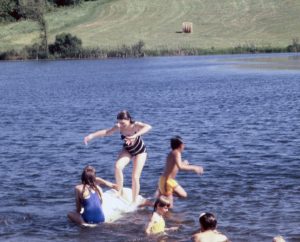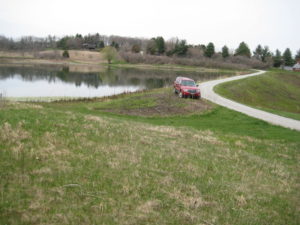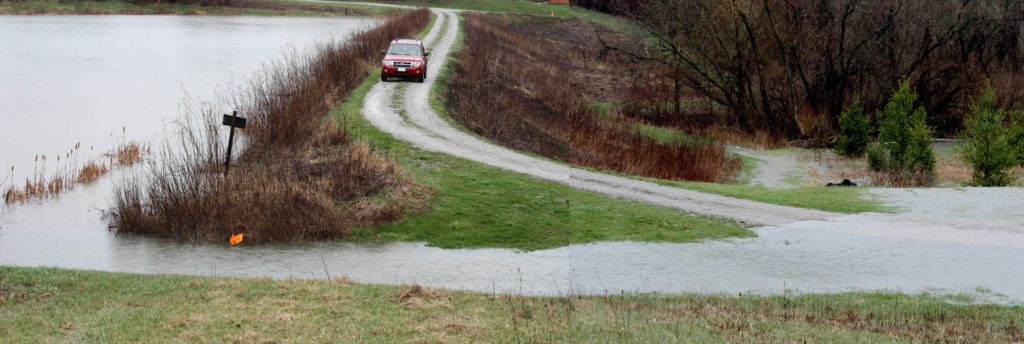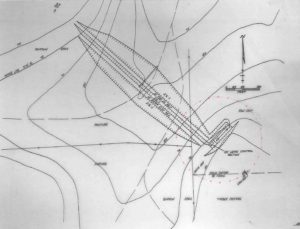Big Ponds Need Professional Design and Sound Construction
My three recent blogs about spillways have featured variations of little ponds in little watersheds, small enough and in locations that if they fail, nobody’s house will get swept away and nobody will die. But as we scale up to ponds that are an acre or more, fed by watersheds of 25-50 acres, we are increasingly creating a dangerous beast in a cage, who wants out. This is no longer at the scale of the backyard frog pond or ice skating rink, and needs the involvement of a professional engineer and an experienced contractor.
Today’s blog is offered assuming that you will not be doing the designing or construction yourself, but rather to illustrate that changes can get made later that your engineer would never have approved. And that long-term maintenance is a big deal. Today’s goal is awareness.

Our nearly six-acre community pond 40 years ago
The safety factors traditionally used for Midwestern “farm ponds” are that if only the dam itself is threatened by its potential failure, then one designs it to safely manage the 25-year flood. If other structures are also potentially at risk, for example a bridge downstream, you scale up design to accommodate the 50-year flood. And if human life could be at risk from failure, for example if there is a house downstream, then you scale up more, to cope with the 100-year storm.
Potential problems with this tradition are that more intensive agriculture in the watershed can make incoming overland flow flashier that the historical record would indicate, and climate change may lead to greater rainfall intensities or frequencies.

Our community pond, grassed spillway in foreground.
With larger ponds, grass spillway designs start getting large enough that people later don’t realize that it is a spillway. For example, our community pond covers nearly six acres fed by a hundred-acre watershed. The 25-year storm design called for a grassed spillway a minimum of 14 feet wide across the floor with gently sloping sides:
After it was built and maintained, a contractor built an access road across it and his new road berm completely blocked future flow. It took me a year to convince him to unblock the spillway, and then he merely installed four little one-foot diameter culverts, which would be almost useless in handling the design flow. It took me nearly another decade of haranguing my neighbors to pay for rerouting the road and rebuilding the spillway close to original specifications. Even this got compromised a bit because in the meantime, electrical lines and telephone wires had been buried near the edges and had to be avoided. Fortunately, the spillway wasn’t actually needed until the flood year of 1993, and by then it was in good condition again and worked as designed.

The community spillway safely diverting overflow away from the earth dam in 2008.

The new plastic trickle tube maintaining pond level
Large ponds also need trickle tubes scaled to the anticipated hydrology. On our big pond, just discussed, the original was an 18-inch corrugated steel culvert that ran down through the middle of the earth dam. About 40 years later it had rusted enough to need replacement, a daunting prospect. Bur fortunately we found a way to slip a heavy-duty 12-inch plastic pipe down inside the rusted steel culvert and seal it in there, avoiding digging a big hole in the center of the dam. This dropped the price of replacement from an estimated $20,000 to an actual cost of $1,200, because the contractor plus three of us residents got the job done in a day with a small backhoe, rather than draining the pond and digging the middle out of the dam. Breaching the dam would have also involved cutting through the road, a buried power cable, telephone lines, and a water main.
The main purpose of the trickle tube is to maintain pond level 24 inches below emergency spillway level. This provides a lot of temporary storage for stormwater inflows, which rise and fall at trickle tube level and only rarely utilize the emergency spillway, which has only actually overflowed three times in the past half century.
And when the spillway is needed, a well-maintained quality grass sod is quite erosion proof if it has a gentle slope and there are no trees, rocks, anthills, logs, parked cars, ruts, and other irregularities to cause swirling turbulence and focus erosion.
There are a half dozen variables involving landscape, rainfall, groundwater, land use, hydrology, etc., that your engineer will factor in to keep the system working. The owner’s concern is management to keep it working as designed.

Plan view of portion of our 1971 blueprint showing spillway specifications (circled in pink dots).

Cross-section of portion of our 1971 blueprint showing original steel culvert trickle tube (pink pipe).
Our community thanks engineer M. Ebert for conservative design, and contractor Daniel Keith Yoder for quality construction, giving us 49 years with a great pond.
Tags: Lon Drake, spillway

